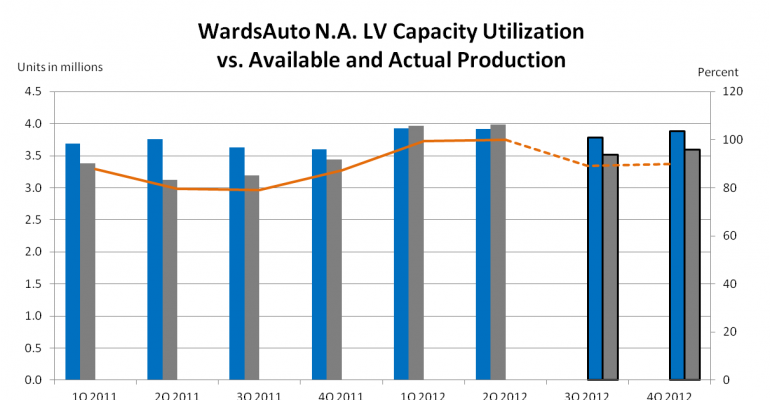Capacity utilization at North American assembly plants hit 100% in the year’s second quarter, marking the first time full capacity has been reached since WardsAuto started tracking the data in 2005.
The Q2 result was an incremental gain on first quarter’s 99.4%, the previous high, and well above like-2011’s 79.5%. The previous second-quarter high was 89.3% in 2006.
Because of vacation downtime at most assembly plants in July and August, WardsAuto forecasts third-quarter capacity utilization to drop to 89.1%, still well above year-ago’s 78.9% and the best rate on record for the quarter.
The fourth quarter also is expected to be the best for the period, with a forecasted 89.8% utilization rate compared with year-ago’s 87.2%.
The capacity utilization data reflects a revision by WardsAuto to its definition of capacity utilization.
To ensure a stronger level of consistency in WardsAuto data, the straight-time volume that production is compared with for realizing utilization rates now assumes two daily shifts for each assembly plant with 5-day workweeks and no downtime. Previously, third shifts were included in the straight-time total for factories that added third shifts to their schedules.
Additionally, incorporating a 2-shift base industrywide will help better gauge a plant’s long-term viability as part of an auto maker’s manufacturing footprint.
Two exceptions to the 2-shift rule are General Motors’ Bowling Green, KY, Chevrolet Corvette facility, and Chrysler’s Conner Ave. factory in Detroit that builds Dodge Viper. Both operations historically have been 1-shift facilities tooled for low-volume production of premium-priced products. The capacity level for each of these plants assumes one shift.
While capacity utilization tracks the general manufacturing health of auto makers, individual assembly plants and platforms, WardsAuto’s “available production” data more closely shows how well auto makers are using their plants to meet demand, as well as their flexibility in meeting future needs.
AP volume shows what assembly plants can build on straight time by adjusting for their actual daily schedules.
Individual plant volumes are determined by taking into account their typical holiday and vacation downtime, long-term model changeover shutdowns and the actual number of shifts a plant runs on its daily schedule, including adjustments when a third shift is added or canceled.
It also accounts for facilities that run 2- or 3-crew systems or 4-day, 10-hour-shift workweeks.
AP in second-quarter 2012 totaled 3.917 million light vehicles, well ahead of prior-year’s 3.762 million. The increase mainly was due to the opening of a new Toyota plant in Blue Springs, MS, in fourth-quarter 2011 and the reopening of two factories that were shut for retooling in 2011.
Also helping were the addition of third shifts or crews at some plants and increases to capacity at others.
Those factors offset the loss of two Ford facilities that were permanently closed in the latter half of 2011 and the temporary closure of a Ford plant that was being refitted for a new product in the middle of second-quarter 2012.
Manufacturers’ LV production equaled 101.1% of their AP in second quarter, compared with 82.8% in like-2011. It was the highest AP utilization rate for any quarter since WardsAuto started tracking the data in 2005.
Third-quarter AP is forecasted at 92.2% and the fourth quarter is pegged at 92.0%, compared with 87.6% and 95.2%, respectively, in like-2011.
Third-quarter volume is projected at 3.783 million units, compared with prior-year’s 3.626 million. Final-quarter 2012 is forecasted at 3.882 million compared with year-ago’s 3.603 million.
The downturn in third- and fourth-quarter AP utilization from the second quarter mostly is due to GM’s early preparation at its GMT900 pickup plants for redesigned versions next year. The three factories building the trucks all have short-term shutdowns scheduled throughout the remainder of the year.
The GM shutdowns, plus the August closure of its Shreveport, LA, plant marking the end of current Chevrolet Colorado and GMC Canyon midsize pickup production, as well as Ford ending Ford Ranger output late last year, mean industry AP for pickup trucks in the last two quarters of 2012 will decline from year-ago.
North American auto makers will have an AP of 576,000 pickups in the July-September period and 532,000 in the October-December timeframe. The third-quarter number is some 34,000 units less than year-ago, but the fourth-quarter total marks a near 45,000-unit decline from like-2011.
The gap would be bigger if Ford had not recently added a second shift at its Kansas City 2 plant that builds F-Series pickups.
More than offsetting the decline in overall pickup production are gains in CUV and small- and midsize-car output.




